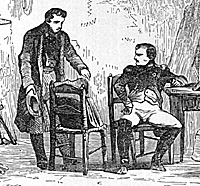 Mr. Ed Wimble of Phoenixville PA has provided some new ideas for his recent game.
Mr. Ed Wimble of Phoenixville PA has provided some new ideas for his recent game.
The following rules options provide a closer look at the tactical differences of the French and Prussian Armies.
The French Morale Track
(See the border of the southern map)
21.1
(modify) Each French corps is provided with a Corps Morale Marker in the countermix. At the start of the Campaign Game, or any scenario for that matter, these markers are placed in the blue box at the top of the track. Every time a combat unit takes a casualty the Corps Morale Marker for that unit's corps is advanced on this track the number of spaces equal the number of casualties thus incurred.
Fatigue
Every time a French combat unit from one of these corps voluntarily moves during a Force March Only turn this marker is advanced one space. Regardless of the number of units that move from an indicated corps later that turn, the Corps Morale Marker is only advanced one space per Force March Only turn.
Recovery From Fatigue and Recovering Casualties
French Corps may recover the effects of fatigue by not moving. Corps recover one space on the French Morale Track for each turn all units of that corps refrain from voluntary movement. The French player(s) must indicate that the corps is in bivouac by marking each unit of that corps with a blank counter. Units in bivouac may not Reorganize.
Every time a French combat unit recovers a casualty increment through reorganization the French Corps Morale Track is simultaneously adjusted one space toward the top. A corps can recover all casualties but still have fatigue. A corps may never recover more fatigue than it has casualties recorded on the track. Corps can become demoralized by the accumulation of casualties; the combined amount of casualties and fatigue; or exclusively through fatigue.
If any part of a corps is adjacent to an enemy unit and they are not separated by a river hexside, then that corps may not enter bivouac and may not recover from fatigue that turn.
he instant the number of casualties and or fatigue recorded an the French Morale Track is equal to or greater than the number prescribed for that corps' demoralization, the corps becomes demoralized.
Sustained Forced March
French corps that force march in consecutive Force March Only turns suffer two (2) fatigue points for the 2nd turn; and x2 fatigue points (or plus 3) for the third turn of force marching. Thus, a corps that in three consecutive Force March Only turns will suffer an accumulated total of 6 fatigue points (1+2x2=6).
Mark the Corps Morale Marker on the Corps Morale Track on the. game map, with a "number" counter , indicating the number of turns of sustained forced. march the corps has undergone to that point in the day. Remove the marker the moment the corps has completed a turn without moving, or, upon entering the 4-8 a.m. (dawn) turn of the next day.
Prussian Linear Deployment
To show that there were advantages in the traditional linear deployment Prussian combat.units may now employ Line as well as the method described in the basic rules that will heretofore be referred to as the Column of March or March Column
Defense
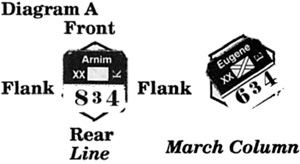 At the option of the Prussian player(s) Divisional
infantry may adopt Linear (or Combat) facing.
To do this face the divisional infantry component toward
the hex vertex as shown.
At the option of the Prussian player(s) Divisional
infantry may adopt Linear (or Combat) facing.
To do this face the divisional infantry component toward
the hex vertex as shown.
Any other parts of the division that stack with the divisional infantry so deployed must also conform to this facing. Deployed as such the stack now has 2 Front, 2 Flank, and 2 Rear hex sides as shown.
Benefits & Disadvantages
The infantry component of each division (including any attached Fusilier/Jager battalions) will thus have a defensive value equal to the sum of multiples given beloiv, per hex, through which it is attacked.
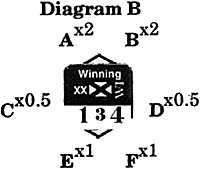 Diagram B
Diagram B
Thus... If attacked solely through hexside A the above unit would defend with a strength of 8; or if through hex sides A and B, 16. If attacked through A and C hex sides it would defend with a SP value of 10; A(8) + C(~) = 10. Or if attacked through hex sides B, D, and F it would defend with a 14; B(8) + C(2) + D(4) 14. Fusilier/Jager battalions combine with the divisional infantry component whereas other units of cavalry or artillery only add their values once.
![]() For Example, Division Tauentzien in a single hex:
For Example, Division Tauentzien in a single hex:
*If attacked through hexside A, 18 (12 for the infantry plus 4 for the artillery and 2 for the cavalry). *If attacked through hexside C, 9 (3 for the infantry plus 4 for artillery and 2 for the cavalry). e If attacked through hex sides A and C 21 (as with A above, but since the artillery and cavalry have already been added only the 1/2 value of the infantry in C will count. *If attacked through A and B 30 (24 for the infantry plus 4 for the artillery and 2 for the cavalry).
Multi-Hex Linear Deployment
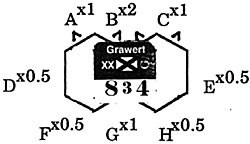 If the divisional infantry component of a division is
currently at a strength of 5 or more (not counting
attached Fusilier/Jager battalions) then that division may
deploy into 2 hexes as shown below. Note that while one
Front hexside has been added (C) so too have two Flank
hex sides (F and H). Attached Cavalry will still have a
Zone of Influence in hex sides A through H.
If the divisional infantry component of a division is
currently at a strength of 5 or more (not counting
attached Fusilier/Jager battalions) then that division may
deploy into 2 hexes as shown below. Note that while one
Front hexside has been added (C) so too have two Flank
hex sides (F and H). Attached Cavalry will still have a
Zone of Influence in hex sides A through H.
Attack
Prussian combat units that are linearly deployed may only attack out of their Front hex sides. They may only attack hexes into which they may advance.
Zum Beispiel; The Unit in Diagram C above may not attack into hexes A and C since it could not advance into both of these hexes at once (see options). It could only advance intD A and B or B and C as shown by the arrows. It deployed in a single hex as in Diagram B, it could only attack hex A or B, not both.
Units attack with the same multiples as they would defend (Exception: Remember that artillery may only bombard on the offense).
![]() Thus, in Diagram C above, Graweres division would attack as follows:
Thus, in Diagram C above, Graweres division would attack as follows:
- If attacking hexes A and B or B and C the formation would have an attacking strength of 40 (inf. = 9 + 18, + cav. = 7 + 6) against the combined defensive strength of those hexes.
- If attacking just hex A or C the formation would have a strength of 22(inf. = 9, cav. = 13).
- If attacking just hex B 31 (inf. = 9x2, Cav(13).
Advance After Assault
Assuming Grawert's division won the assault and both hexes A and B or B and C were vacated: The advance after battle morale check would be made (remember to modify it by a +1 for winning). Only one die roll is made for the division. If all parts of the linear formation pass this check then the division may advance. If all parts did not pass then no part of it may advance. If advancing the division must advance into both attacked/vacated hexes, maintaining its linear deployment. Because foot artillery may not advance as a result of combat it must be left behind in one of the two original hexes (player option as to which).
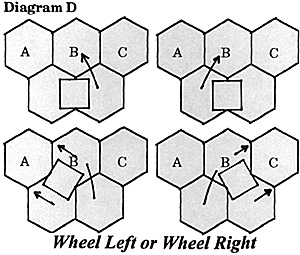 Assuming only one hex, either A, B or C were
attacked in Diagram C. The vacated hex must be
occupied assuming the roll to advance was successful.
Therefore, Grawert's division would advance according
to Diagram D:
Assuming only one hex, either A, B or C were
attacked in Diagram C. The vacated hex must be
occupied assuming the roll to advance was successful.
Therefore, Grawert's division would advance according
to Diagram D:
Bombarding Artillery
When part of a multi-hex linear deployment artillery may only bombard enemy units in its front hex sides. If there are two units to be attacked then its value must be apportioned as equally as possible between the, two hexes the rest of the formation will attack. If the linear formation is not going to attack then its value must be apportioned between all three front hexes.
In other words, an artillery unit with a gun strength of three would make three 1 point attacks, or, two attacks (if only two opposing hexes are occupied), one of 2 points and one of 1 point. Do not use fractions when tabulating gun strengths. The gun strength of a bombardment attack may never be less than 1. Therefore, an artillery unit of only one SP would still make three 1 point attacks if all three front hex sides were occupied by opposing units, as would an artillery unit of only 2 SPs.
Linear Movement and Deployment
Units that deploy linearly may only move through their front hex sides (or into front hexes). If deployed in two hexes they may also wheel to left or right but may not about-face.
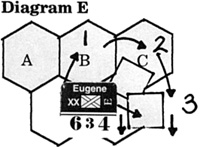 Diagram E
Diagram E
All linear movement must be done in terrain that is not swamps, forest, woods, town, city, or village hexes. Slopes, crests, and stream hex sides do not prohibit linear movement although the cost may increase.. Units may only deploy linearly in, and ma only attack into, hexes they may move into.
Deploying into line in one hex cost 1/2 a movement point. Deploying into two hexes requires that the unit first deploy into a single hex, and then expand into the second hex at the normal movement point cost for that hex and the hexside crossed. Ploying ou of line is done at exactly the same cost as deploying into line. Just reverse the procedure. Units linearly deployed may not cross bridges or take advantage of road or highway movement rates.
Combat Results and The Advanced Rule
The attacking or defending player no longer has the choice to hold ground at the cost of increments, or to yield it as in the Ar, Ar2, Dr, or Dr2 results. If oni of these results are rolled on the die the player rolls again to check the unit's morale (modified by a -1 for losing the fight per usual). If the unit, or stack, fails this check then they must retreat the required distance. If they pass this check the result is treated as an EX*; the odds retabulated and the attack renewed.
Given the variety of morale values in a stack some units may fail and retreat while others stand. In the case of a linear unit in two hexes attacking two hexes wherein one of the defending hexes was vacated, the linear unit may advance by wheeling into it, thereby bringing its full weight to bear on the stack or unit that stood.
10.41 (Modify)
Units must attempt to advance into hexes vacated b, defending units if the hex was left vacant as a result of an attack.
The Attack Combat Results Table
When attacking fortified towns which result in a Dr2, the resulting exchange sees both the attacker and defender losing 2 increments.
Back to Art of War Issue #29 Table of Contents
Back to Art of War List of Issues
Back to MagWeb Master Magazine List
© Copyright 1998 by Clash of Arms Games.
This article appears in MagWeb (Magazine Web) on the Internet World Wide Web.
Other military history articles and gaming articles are available at http://www.magweb.com